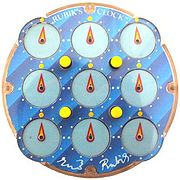
Rubik's Clock
Encyclopedia

Mechanical puzzle
A mechanical puzzle is a puzzle presented as a set of mechanically interlinked pieces.- History :The oldest known mechanical puzzle comes from Greece and appeared in the 3rd century BC....
invented and patent
Patent
A patent is a form of intellectual property. It consists of a set of exclusive rights granted by a sovereign state to an inventor or their assignee for a limited period of time in exchange for the public disclosure of an invention....
ed by Christopher C. Wiggs and Christopher J. Taylor. The Hungarian
Hungary
Hungary , officially the Republic of Hungary , is a landlocked country in Central Europe. It is situated in the Carpathian Basin and is bordered by Slovakia to the north, Ukraine and Romania to the east, Serbia and Croatia to the south, Slovenia to the southwest and Austria to the west. The...
sculptor and professor of architecture Ernő Rubik
Erno Rubik
Ernő Rubik is a Hungarian inventor, architect and professor of architecture. He is best known for the invention of mechanical puzzles including Rubik's Cube , Rubik's Magic, Rubik's Magic: Master Edition, Rubik's Snake and Rubik's 360....
bought the patent from them to market the product under his name. It was first marketed in 1988.
Rubik's Clock is a two-sided puzzle
Puzzle
A puzzle is a problem or enigma that tests the ingenuity of the solver. In a basic puzzle, one is intended to put together pieces in a logical way in order to come up with the desired solution...
, each side presenting nine clocks to the puzzler. There are four wheels, one at each corner of the puzzle, each allowing the corresponding corner clock to be rotated directly. (The corner clocks, unlike the other clocks, rotate on both sides of the puzzle simultaneously and can never be operated independently. Thus the puzzle contains only 4 independent clocks.)
There are also four buttons which span both sides of the puzzle; each button arranged such that if it is "in" on one side it is "out" on the other. The state of each button (in or out) determines whether the adjacent corner clock is mechanically connected to the three other adjacent clocks on the front side or on the back side: thus the configuration of the buttons determines which sets of clocks can be turned simultaneously by rotating a suitable wheel.
The aim of the puzzle is to set all nine clocks to 12 o'clock (straight up) on both sides of the puzzle simultaneously.
It is actually very easy to solve this puzzle. One reason for this is that unlike (for example) Rubik's Cube
Rubik's Cube
Rubik's Cube is a 3-D mechanical puzzle invented in 1974 by Hungarian sculptor and professor of architecture Ernő Rubik.Originally called the "Magic Cube", the puzzle was licensed by Rubik to be sold by Ideal Toy Corp. in 1980 and won the German Game of the Year special award for Best Puzzle that...
, the Clock is a commutative puzzle: the order in which operations are done does not matter. (This is true provided we understand "operation" to mean an action of "setting the buttons and then rotating a wheel"—of course individual button moves do not commute with wheel moves.) Consequently a complete mathematical solution can be obtained merely using techniques of linear algebra
Linear algebra
Linear algebra is a branch of mathematics that studies vector spaces, also called linear spaces, along with linear functions that input one vector and output another. Such functions are called linear maps and can be represented by matrices if a basis is given. Thus matrix theory is often...
without involving the subject of group theory
Group theory
In mathematics and abstract algebra, group theory studies the algebraic structures known as groups.The concept of a group is central to abstract algebra: other well-known algebraic structures, such as rings, fields, and vector spaces can all be seen as groups endowed with additional operations and...
which is often required in sequential move puzzles.
The current world record for solving the puzzle is held by Javier Tirado Ortiz, with a time of 5.83 seconds, set at the World Championship 2011.
External links
- Rubik's Clock Solution An illustrated description of the solution.
- Unofficial Records Speedcubing.com's page of unofficial records for the Rubik's Clock
- Online Rubik's Game (Official) Official Flash version of Rubik's Clock
- Real Genius Computer game implementation of Rubik's Clock for the Commodore Amiga, released in 1989

